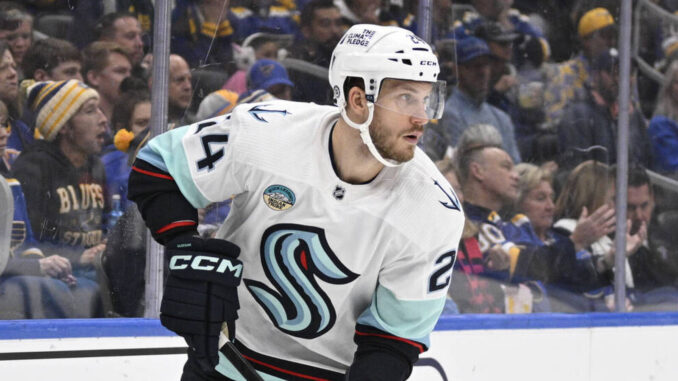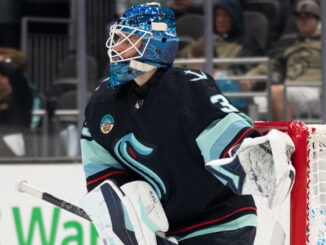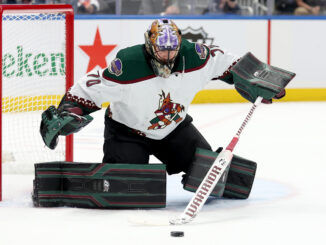
After kicking off the 2023-24 season with a four-game winless streak, the Seattle Kraken pulled out a 7-4 statement win over a Stanley Cup contender in the Carolina Hurricanes on Oct. 19 but subsequently lost 4-1 to the New York Rangers this weekend (Oct. 21) to halt any potential momentum.
Last week’s results moved the team’s record to 1-4-1 (three points) as we head into the third week of the new season. They currently sit 14th in the Western Conference, ahead of only the bottom-feeding Anaheim Ducks and San Jose Sharks.
Over the first six games, the Kraken have scored 11 goals and allowed 21, and currently sport a goal differential of minus-10. Only the Sharks (minus-13) now carry a worse differential. For a team looking to build on a first-ever playoff series win, that’s not the sort of company you want to keep.
So, what’s behind the slow start? Can the Kraken return to their swashbuckling ways of last season? Let’s dive into three of the most significant factors driving the early slump and how likely each trend will swing back in Seattle’s favor.
Factor #1: Unsustainable Finishing Luck (Or a Lack Thereof)
Look – we should have seen this coming. Whether you have been an ardent supporter of the Kraken during their brief existence or their biggest critic, most fans would agree that Seattle’s incandescent team shooting percentage (SH%) last season of 11.6% – second in the NHL – was bound to crash back down to Earth.
Across what is admittedly an extremely small sample size, the Kraken rank 30th in the NHL with a 6.1% SH%, most of which is driven by shooting 4.2% at five-on-five – third-worst in the league. For reference, the Kraken led the league last season with a 10.3% clip at five-on-five, with eight players converting at a 10.5% clip or better.
Related: 4 Bold Predictions For The 2023-2024 Seattle Kraken Season
While they can (and should) point to their terrible shooting luck as the major culprit in their slow start, they haven’t generated shot quality at a rate that suggests they deserve many more goals than they’ve scored. They sit in the bottom third of the league in terms of expected goals for per-60-minutes (xGF/60) at both five-on-five (28th) and in all situations (25th).
Basic statistical principles suggest they should find their footing eventually, but don’t expect the barrage of goals driven by red-hot finishing, which powered their success last season.
Factor #2: An Inconsistent Power Play
After noting that the Kraken’s SH% currently resides somewhere deep in the Earth’s core, it follows that their luck with the man advantage had followed a similar pattern.
Before erupting against the Hurricanes, scoring on two of four opportunities, the Kraken powerplay scored at a 9.1% clip (24th). Their conversion rate has risen to a slightly more respectable 16.7% (18th), but that early dry spell contributed to their 0-3-1 record through four games.
As was the case at five-on-five, the Kraken are just not generating enough shots and chances with the man-advantage to warrant a jump in scoring. According to Natural Stat Trick, they rank 23rd or lower in terms of their rate of shots (27th), xGF (28th), scoring chances (27th), and high-danger chances on the power play (23rd).
A strong process should take precedence over unsustainable practices in either direction and employing above-average finishers (like Jared McCann) can help paper over the cracks in chance creation. Still, the Kraken are getting neither at the moment.
Factor #3: Goaltending (Again)
Despite what their goal-margin might indicate, the Kraken’s goaltending hasn’t been completely incompetent, but neither netminder can mask the rest of the team’s shortcomings.
Joey Daccord (.918 in two games) and Philipp Grubauer (.896 in four) have posted individual save percentages (SV%) on different ends of the netminding spectrum. I should note that both own positive goals saved above expected(GSAx) margins through multiple appearances.
Related: 3 Seattle Kraken Prospects Ready For The NHL In 2023-2024
Grubauer has yet to win a game in four appearances, however, so he’s once again struggling to meet the heightened expectations brought on by his $5.9 million cap hit after being a noticeable crutch in both of the Kraken’s first two seasons. He ranks 50th among 52 goalies to have played at least two games in SV%, a far cry from what’s expected from someone of his stature.
The Kraken are allocating $7.1 million to their goaltending this season (the ninth-highest total in the NHL according to CapFriendly), so getting an adequate return on investment is crucial while managing such a finite resource.
Finding success in the crease could ultimately be the difference between stagnating as a playoff bubble team and challenging for the divisional crown, so any growth in this department should be celebrated. The Kraken remain a fair bit away from legitimate Stanley Cup contention, however, but any improvement is a good sign.
Plenty of Positives for the Kraken Amid Early Slump
Despite the undeniably rocky start, the Kraken should not pack it in before the calendar even turns to November. There are definite causes for concern, don’t get me wrong, but the Kraken have the tools to climb back into the playoff picture in short order and emerge relatively unscathed.
The goaltending is approaching competency, the penalty kill has been strong, and they’ve generally been near 50% in the shot- and chance-share battle at five-on-five. Their finishing is the biggest underlying factor driving their poor results, but luckily, time and the law of averages are both on their side.
The Kraken also benefit from playing in the Pacific, arguably the NHL’s weakest division. According to Tankathon’s Strength-of-Schedule (SOS) metric, Seattle has the fifth-easiest remaining slate of games, with four matchups against both the Sharks and Anaheim Ducks still to come.
Of course, blind optimism doesn’t help the fans or employees of the organization, but the numbers suggest that the time to panic is closer to Thanksgiving, not before the candy has been handed out on Halloween. Rest easy and enjoy the sweets Kraken faithful; better times await.
Data courtesy of Evolving Hockey, Hockey Reference, Natural Stat Trick, and the NHL. Statistics are accurate as of Oct. 23.




